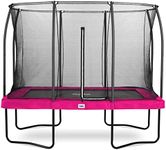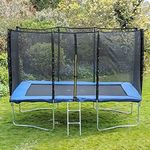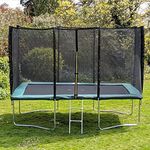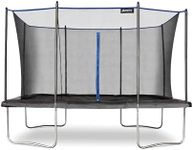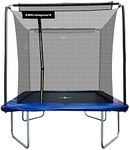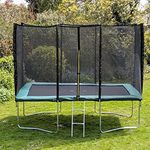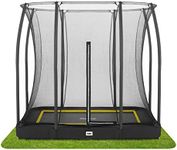Buying Guide for the Best Rectangular Trampolines
When choosing a rectangular trampoline, it's important to consider several key factors to ensure you select the best fit for your needs. Rectangular trampolines are popular for their even bounce and are often preferred by gymnasts and athletes. However, they can also be a great choice for families and recreational use. Understanding the specifications will help you make an informed decision that balances safety, performance, and enjoyment.SizeThe size of a rectangular trampoline is crucial as it determines the space available for jumping and the number of users it can accommodate. Sizes can range from small (around 7x10 feet) to large (up to 10x17 feet or more). Smaller trampolines are suitable for limited spaces and younger children, while larger ones are ideal for older kids, multiple users, or those practicing gymnastics. Consider the available space in your yard and the primary users when selecting the size.
Weight CapacityWeight capacity indicates the maximum weight the trampoline can safely support. This is important for safety and durability. Trampolines with higher weight capacities (up to 500 pounds or more) are suitable for multiple users or heavier individuals, while those with lower capacities (around 200-300 pounds) are better for single users or lighter individuals. Assess who will be using the trampoline most frequently to determine the appropriate weight capacity.
Frame MaterialThe frame material affects the trampoline's durability and stability. Most frames are made from galvanized steel, which is resistant to rust and provides strong support. Some trampolines may use powder-coated steel for additional protection. A sturdy frame is essential for safety and longevity, especially if the trampoline will be used frequently or left outdoors year-round. Consider the climate and expected usage when evaluating frame materials.
Spring Count and QualitySprings are responsible for the trampoline's bounce. The number and quality of springs can significantly impact performance. More springs generally mean a better bounce, with high-quality, rust-resistant springs offering superior performance. Trampolines with fewer springs may be suitable for casual use, while those with more springs are better for athletes or those seeking a higher bounce. Consider your intended use and desired bounce quality when assessing spring specifications.
Safety FeaturesSafety features are critical to prevent injuries. Look for trampolines with safety nets, padded frames, and secure enclosures. A safety net prevents falls, while padding covers springs and frames to reduce impact injuries. Some trampolines also offer reinforced enclosures for added security. If the trampoline will be used by children or multiple users, prioritize models with comprehensive safety features to ensure a safe jumping environment.
Mat MaterialThe mat material affects the trampoline's bounce and durability. Most mats are made from polypropylene or similar materials that are UV-resistant and designed to withstand outdoor conditions. A high-quality mat will provide a consistent bounce and resist wear and tear over time. If the trampoline will be used frequently or exposed to harsh weather, opt for a mat made from durable, weather-resistant materials to ensure longevity.





